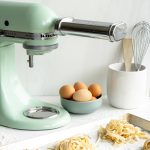
KitchenAid Pasta Recipe (Foolproof Homemade Pasta)
Making fresh, homemade pasta dough isn't hard! This simple recipe takes the guesswork out of making the dough, and using the KitchenAid pasta attachment makes it extra easy.
Servings 4 people
Calories 330kcal
Ingredients
- 300 g all-purpose flour, plus extra flour for handling the dough
- 3 eggs
- 1 teaspoon olive oil
- pinch of salt
Instructions
To make the pasta dough
- In a mixing bowl, add flour. Make a well in the center of the flour and add the eggs. Add the eggs, salt and olive oil.
- In the bowl, start mixing the ingredients together with your hands, about one minute.
- Once you have a work-able "ball," that holds together (it will still be crumbly at this point), transfer the dough to a working surface, whether that's a table, or a wooden board.
- On your working surface, knead the dough until it's yellow in colour and holds together nicely, about 10 minutes.
- Form dough into a ball and wrap in saran wrap and let it rest at room temperature for 30 minutes.
To make the pasta sheets with the KitchenAid pasta attachment
- Attach your pasta roller attachment to the power hub of your KitchenAid stand mixer.
- On a lightly floured surface, cut your ball of pasta dough into 3 equal-sized pieces. Flatten each piece with your hands.
- Lightly flour your hands. On speed 2 and setting 1 on the pasta roller, feed one piece of flattened dough through the roller. Once it has gone through, fold the dough into 3, rotate and feed through again. Rotating the dough is what makes it rectangular in shape. Repeat this process two more times until you've fed all sides of the dough through at setting 1.
- Now change your roller setting to 2 and feed the dough through the roller once. Keep flouring your hands if dough is sticky.
- Keep feeding the dough through on each roller setting (only once) until you've reaching setting 7. I found this was a good thickness for fettucine. Set your dough sheet aside and repeat these steps for the remaining pieces of dough.
- You now have basic, work-able pasta dough sheets! You can make spaghetti, fettucine, ravioli. tortellini, whatever you want from this dough.
To make fettuccine or spaghetti:
- Grab a sheet of pasta dough and cut it into about 3 equal pieces. If you feed the whole sheet through without cutting, your fettuccine will probably be too long to eat.
- Add the fettucine or spaghetti attachment to the power hub of your KitchenAid stand mixer. On speed 2, feed the pasta dough sheet through.
- On a floured baking sheet, place each set of fettuccine/spaghetti on the baking sheet into a pile or "nest" shape.
Video
Notes
- This recipe will serve 4 people, but if you want to make more or less pasta dough, a general rule of thumb to follow is: use 1 egg per 100 grams of flour. Ie. if you use 500g of flour, use 5 eggs.
- If you can, when you're kneading your dough, knead on a surface that's room temperature like a table or large wood cutting board. I've heard that if you knead on a cold surface like marble or quartz, the dough won't turn out as well.
- Kneading this dough takes me about 10 minutes, but depending on your strength, it could be more or less time. When kneading, you will notice that there's always an "open" side to the dough, where the dough looks like it's cracking and about to open. Try to keep this open side face up when you're kneading.
- Extra all purpose flour is required at many stages of the pasta making process so that it doesn't stick together. Add flour to the pasta sheets once you've rolled them out and placed them aside, on a floured surface as well. Add flour to fettuccine or spaghetti once you've formed them into a nest shape.
Nutrition
Calories: 330kcal | Carbohydrates: 57g | Protein: 11g | Fat: 4g | Saturated Fat: 1g | Cholesterol: 122mg | Sodium: 48mg | Potassium: 125mg | Fiber: 2g | Vitamin A: 180IU | Calcium: 30mg | Iron: 4.1mg